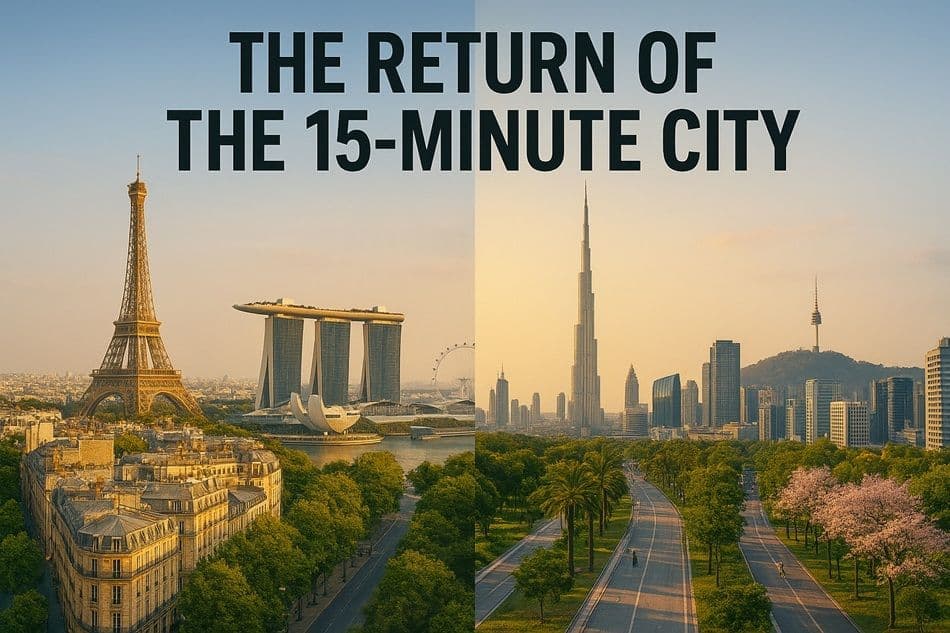Ask GRAI Anything
Your Real Estate Questions, Answered Instantly via Chat


Help us make GRAI even better by sharing your feature requests.

The defining urban story of the 2020s isn’t about taller skylines or faster transport. It’s about shrinking the distance between life’s essentials.
The 15-minute city - once dismissed as utopian urban theory - has become the new design logic for global metros. And it’s rewriting both how people live and where investors put their money.
The pandemic compressed geography. As remote work and e-commerce scaled, the “megacity advantage” eroded. People began valuing time, air, and access more than square footage.
At the same time, climate stress and infrastructure fatigue forced cities to re-think sprawl. OECD data shows that urban commute times rose 23% between 2010-2020 while productivity gains stagnated.
By 2025, the economic cost of congestion alone equals 1-2% of GDP across major metros.
The solution: make cities smaller - from within.
Paris - From Concept to Codified Policy
Mayor Anne Hidalgo’s “Ville du Quart d’Heure” is no longer a slogan:
20%-30% of office buildings in central Paris are being rezoned into housing.
Bicycle network expansion has cut car traffic by -35% since 2019.
Local retail density is going up proving the micro-economy multiplier effect. Result: average property prices in walkable districts hold significant premiums over outer arrondissements

Singapore - Engineering Walkability into Policy
The Long-Term Plan 2040 divides the island into self-contained “nodes” - each with jobs, schools, healthcare, and recreation within 20 minutes.
Punggol Digital District integrates 28,000 workspaces, housing, and a university campus.
The Cross-Island Line will link all major nodes by 2033, reducing car ownership significantly. The long-term goal is for public, active, and shared transport to account for nine in ten (90%) of all peak-period journeys by 2040.
Livability isn’t a lifestyle perk here - it’s a national productivity lever.

Dubai - From Megaproject to Multi-Center
The Dubai 2040 Urban Master Plan defines five urban centers (Downtown, Deira, Jumeirah, Expo, Silicon Oasis) to cut average commute times by 20%.
Public-transit coverage has expanded to 55% of residents within 800 m of a station.
Each zone now mixes housing, green corridors, and commercial density - making Dubai one of the few car-first cities turning back toward human scale.

Seoul - Compact Smart Growth
Seoul’s “3D City Model” integrates transport, zoning, and data layers to plan micro-districts dynamically.
Seoul's urban planning efforts have resulted in a significant expansion of pedestrian infrastructure, including the creation of over 200 km of greenways since 2022 and plans for further expansion.
Seoul's transit-oriented development (TOD) strategy includes policies that incentivize the creation of high-density, mixed-use blocks within walking distance of public transportation.
The city projects 30% GDP efficiency gains from reduced mobility costs by 2030.

The 15-minute model works because proximity creates compounding value.
| Metric | Walkable Districts | Car-Dependent Suburbs |
|---|---|---|
| Avg price premium | +18%-22% | Baseline |
| Rental occupancy | 96% | 89% |
| SME density growth (2019–25) | +24% | +7% |
| Carbon footprint per resident | –28% | Baseline |
Investors once paid for skyline views; now they pay for sidewalk certainty.
Also Read: How Global Capital Is Reshaping Real Estate Markets in 2025
Zoning rigidity: Converting commercial blocks into housing remains bureaucratically slow in most OECD markets.
Equity tension: Walkable districts risk “green gentrification” - rising prices that exclude lower-income residents.
Data deficit: Many cities lack granular livability and accessibility metrics to guide policy and investment.
Without quantifiable frameworks, “15-minute living” risks becoming branding, not infrastructure.
GRAI transforms livability from an idea into measurable value.
“Compare ROI of 15-minute zones vs commuter belts across global metros.”
“Quantify rent premiums tied to walkability and mixed-use zoning.”
“Simulate emissions reduction from reduced-commute infrastructure.”
“Forecast property appreciation under proximity-based urban plans.”
Compare 15-Minute City ROI with GRAI - https://internationalreal.estate/chat
The city of the future isn’t defined by skyscrapers or sprawl - it’s defined by access.
The winners will be the metros that compress life without constraining it - where livability, productivity, and sustainability occupy the same square kilometer.
In the 20th century, cities were built for speed.
In the 21st, they’re being rebuilt for time.